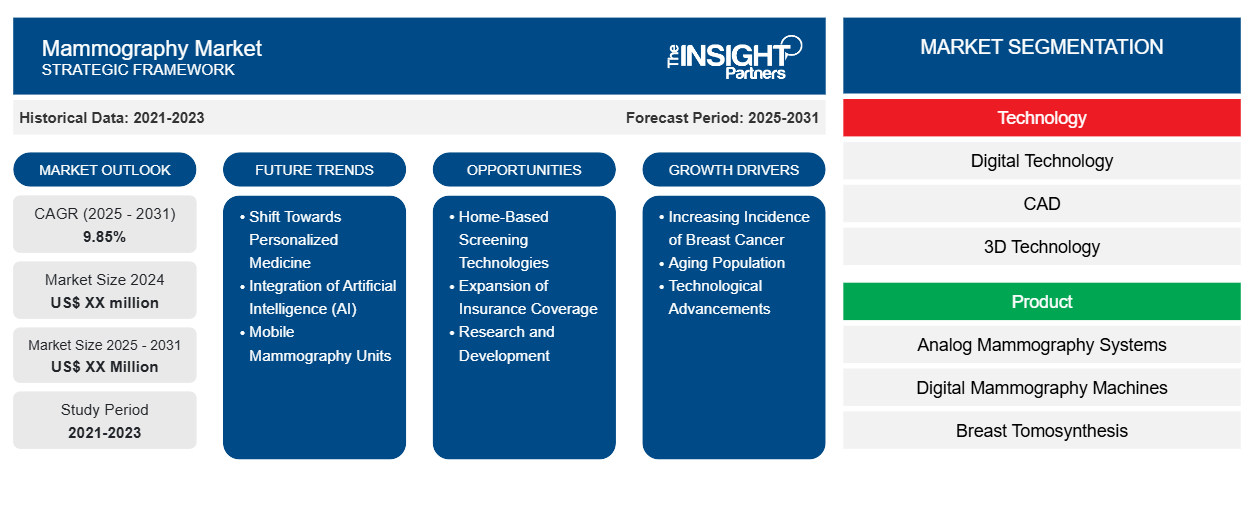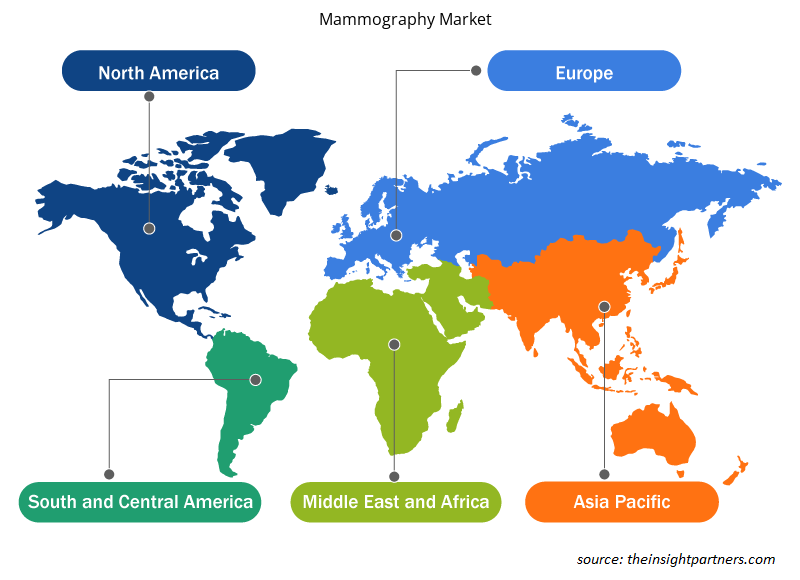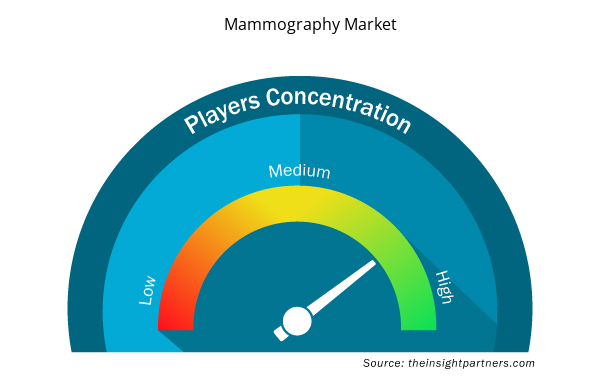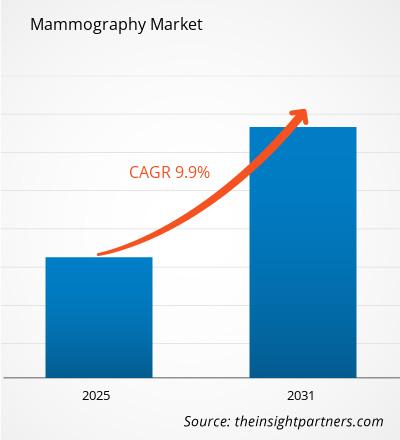The Mammography Market is expected to register a CAGR of 9.85% from 2025 to 2031, with a market size expanding from US$ XX million in 2024 to US$ XX Million by 2031.
The report is segmented by Technology (Digital Technology, CAD, and 3D Technology), Product (Analog Mammography Systems, Digital Mammography Machines, and Breast Tomosynthesis), End User (Hospitals, Ambulatory Surgical Centers, and Specialized Diagnostic Centers)
Purpose of the Report
The report Mammography Market by The Insight Partners aims to describe the present landscape and future growth, top driving factors, challenges, and opportunities. This will provide insights to various business stakeholders, such as:
- Technology Providers/Manufacturers: To understand the evolving market dynamics and know the potential growth opportunities, enabling them to make informed strategic decisions.
- Investors: To conduct a comprehensive trend analysis regarding the market growth rate, market financial projections, and opportunities that exist across the value chain.
- Regulatory bodies: To regulate policies and police activities in the market with the aim of minimizing abuse, preserving investor trust and confidence, and upholding the integrity and stability of the market.
Mammography Market Segmentation
Technology
- Digital Technology
- CAD
- 3D Technology
Product
- Analog Mammography Systems
- Digital Mammography Machines
- Breast Tomosynthesis
End-User
- Ambulatory Surgical Centers
- Hospitals & clinics
- Others
Geography
- North America
- Europe
- Asia-Pacific
- South and Central America
- Middle East and Africa
Customize This Report To Suit Your Requirement
You will get customization on any report - free of charge - including parts of this report, or country-level analysis, Excel Data pack, as well as avail great offers and discounts for start-ups & universities
Mammography Market: Strategic Insights

- Get Top Key Market Trends of this report.This FREE sample will include data analysis, ranging from market trends to estimates and forecasts.
Mammography Market Growth Drivers
- Increasing Incidence of Breast Cancer: The global burden of breast cancer is rising, primarily due to changing lifestyles and environments, as well as from increased awareness and screening of the disease. While some of the increase in cases, the detection of breast cancer using x-ray pictures of breasts called mammograms is also a considerable aspect. Health organizations advocate women most especially above 40 or 50 years depending on the risk factors should do regular screening tests using x-rays of the breast called mammograms. The introduction of screening programs has increased the number of breast cancer cases diagnosed complicatedly, especially among younger women who were not routinely screened before.
- Aging Population: As the women grows older, breast cancer is also on the rise and this is because of the age factor associated with the disease. Most of the cancer cases are reported for women aged over 50 years. Therefore, it is essential for women over this age to keep on undertaking regular screenings. The issue of when to cease screening is however an area that is contentious as the advantages and disadvantages particularly those associated with false positive and over diagnosis are considerations. There is need for such approaches as the screening initiatives for such aged women population have to recommend age prudent individualized screening schedules.
- Technological Advancements: Emerging technologies in mammography techniques such as digital mammography and 3d tomosynthesis have enhanced the diagnostic power especially among patients with complicated breast structures. These methods help in imaging and separating cancerous from normal growths for the radiologists thus lowering the risk of undertaking unnecessary surgical procedures to remove non-threatening tissues. With the rapid development of AI instrumental for machine learning systems especially in the field of radiology, it is also employed in reading mammograms focusing on identifying tumours that might be overlooked by the human eye. This can reduce the workload on radiologists and improve screening accuracy, providing valuable support in clinical decision-making
Mammography Market Future Trends
- Shift Towards Personalized Medicine: There is a growing awareness that one-size-fits-all approaches may not be most effective. Personalized medicine in the context of mammography is based on assessing the individual risk like family history, genetics and breast density. This empowers healthcare professionals to tailor when and how women are screened for cancer, thus improving chances of detecting cancer early to a great extent bettering patient prognosis. However, with the enhancement of genetic testing, it is now possible to more accurately evaluate the likelihood of developing breast cancer. Given that more women are undergoing genetic abnormalities testing for breast cancer such as the BRCA1 and BRCA2 mutations, it is possible to fine-tune the mammography approach. Greater focus on patient involvement in the process of forming the screening strategy is manifest together with presenting the patients’ values and preferences. This transition is likely to contribute to the improve acceptance of screening recommendations as well as the care experienced by the patients.
- Integration of Artificial Intelligence (AI): Mobile mammography units are important in accessing and reaching out to populations that are at risk of being underserved, especially in rural or low-income areas where healthcare facilities are scarce. It is these units that bring screening services to the doorsteps of the women, helping to create awareness and compliance on mammography screening. A good number of the health care organizations nowadays are sourcing for support from the local authorities and non-profit organizations in providing these services as part of the community health care intervention. Such programs also tend to include informing people about the disease breast cancer and sensitizing them about the need to screen for it. This tends to lowers the patient volume in such services during the traditional years, however it provides readily available services with high quality diagnostic images. Some of these units are now combining the technology of digitalization in carrying out mammography system and even tomosynthesis where 3D imaging is done, which enhances detection of breast cancers.
- Mobile Mammography Units: Over the recent years, the use of AI solutions has also been incorporated to assist the radiologists interpreting mammograms. AI enables improvement in the accuracy and efficiency of readings by reducing both false positives and false negatives. Such systems can help reduce the turnaround times in the reporting process of patients by organizing cases in a hierarchical manner whereby urgent cases are tackled first. This improves the quality of services offered to the patients and also helps in resource management in the organizations. AI deals with big data and does statistical modeling to highlight patterns and risk factors which helps in designing more effective screening policy and strategies. Such ability enables them to support the decision making processes of the clinicians in regard to the patients care.
Mammography Market Opportunities
- Home-Based Screening Technologies: Screening, particularly in the rural or unserved regions, can benefit from Portable Mammography Devices with the ability for it to be used indoors and in areas with less resources. The advancements in smaller, easier-to-use devices may encourage women to become more proactive with their healthcare. Home-based screening would also have teleconsultation services, which would allow patients to consult a doctor without booking an appointment with them. Such devices are tailored to treat the patient’s anxiety; step-by-step assists them to overcome the fear, and explain and interpret the results. If people are encouraged to use home-based mammograms aided by digital enhancement, then the potential for diagnosis of breast cancer at earlier stages may become more prevalent.
- Expansion of Insurance Coverage: With more countries insisting on better access to health care, so also does the need become pressing for insurance coverage for home based screening device as well as technologies for newer and better mammography such as the 3D mammography. Already, Insurers are making it mandatory to screen for a broader range of high-risk patients e.g. those with a family member who had breast cancer which will increase the uptake of such screenings hence there is mammography market growth. Where the economic model in place for more comprehensive services such as the mammogram is the bundled diagnostic service, this can enhance the ease of payment and potentially motivate the providers to include screening mammograms.
- Research and Development: Researchers are consistently looking for more advanced imaging techniques (3D mammography, MRI, ultrasound with mammography) in particular breast cancer diagnosis. Enhancing available technology and techniques is likely to increase the sensitivity and specificity of breast cancer screening. Thus, there is the potential for some investment in finding and proving new biomarkers which might allow for some sort of non-invasive screening option or assist in more clearly defining the risks. Development of applications incorporating artificial intelligence to assist the interpretation of mammograms may lead to improvement of efficiency, and a reduction of the crucial miss/overcall ratios. Demonstrating the use of emerging mammography technologies and home screening devices in clinical trials can help garner positive outcomes that support the use of such devices in the larger market and reimbursement.
Mammography Market Regional Insights
The regional trends and factors influencing the Mammography Market throughout the forecast period have been thoroughly explained by the analysts at Insight Partners. This section also discusses Mammography Market segments and geography across North America, Europe, Asia Pacific, Middle East and Africa, and South and Central America.

- Get the Regional Specific Data for Mammography Market
Mammography Market Report Scope
| Report Attribute | Details |
|---|---|
| Market size in 2024 | US$ XX million |
| Market Size by 2031 | US$ XX Million |
| Global CAGR (2025 - 2031) | 9.85% |
| Historical Data | 2021-2023 |
| Forecast period | 2025-2031 |
| Segments Covered |
By Technology
|
| Regions and Countries Covered | North America
|
| Market leaders and key company profiles |
Mammography Market Players Density: Understanding Its Impact on Business Dynamics
The Mammography Market market is growing rapidly, driven by increasing end-user demand due to factors such as evolving consumer preferences, technological advancements, and greater awareness of the product's benefits. As demand rises, businesses are expanding their offerings, innovating to meet consumer needs, and capitalizing on emerging trends, which further fuels market growth.
Market players density refers to the distribution of firms or companies operating within a particular market or industry. It indicates how many competitors (market players) are present in a given market space relative to its size or total market value.
Major Companies operating in the Mammography Market are:
- Siemens AG
- Koninklijke Philips N.V.
- CANON MEDICAL SYSTEMS CORPORATION
- GENERAL ELECTRIC
- Hologic Inc.
Disclaimer: The companies listed above are not ranked in any particular order.

- Get the Mammography Market top key players overview
Key Selling Points
- Comprehensive Coverage: The report comprehensively covers the analysis of products, services, types, and end users of the Mammography Market, providing a holistic landscape.
- Expert Analysis: The report is compiled based on the in-depth understanding of industry experts and analysts.
- Up-to-date Information: The report assures business relevance due to its coverage of recent information and data trends.
- Customization Options: This report can be customized to cater to specific client requirements and suit the business strategies aptly.
The research report on the Mammography Market can, therefore, help spearhead the trail of decoding and understanding the industry scenario and growth prospects. Although there can be a few valid concerns, the overall benefits of this report tend to outweigh the disadvantages.
- Historical Analysis (2 Years), Base Year, Forecast (7 Years) with CAGR
- PEST and SWOT Analysis
- Market Size Value / Volume - Global, Regional, Country
- Industry and Competitive Landscape
- Excel Dataset



Report Coverage
Revenue forecast, Company Analysis, Industry landscape, Growth factors, and Trends

Segment Covered
This text is related
to segments covered.

Regional Scope
North America, Europe, Asia Pacific, Middle East & Africa, South & Central America

Country Scope
This text is related
to country scope.
Frequently Asked Questions
The mammography market majorly consists of the players such as Siemens AG, Koninklijke Philips N.V., CANON MEDICAL SYSTEMS CORPORATION among others.
The mammography market is estimated to grow with a CAGR of 9.8% from 2023 to 2031.
Asia Pacific region is likely to witness fastest growth rate during the forecast period.
Mobile Mammography Units is likely to remain the key trend during the forecast period
The market drivers include Increasing Incidence of Breast Cancer and Technological Advancements are driving the mammography market
North America dominated the mammography market in 2023
Trends and growth analysis reports related to Life Sciences : READ MORE..
1. Siemens AG
2. Koninklijke Philips N.V.
3. CANON MEDICAL SYSTEMS CORPORATION
4. GENERAL ELECTRIC
5. Hologic Inc.
6. Analogic Corporation
7. FUJIFILM Holdings Corporation
8. PLANMED OY
9. Carestream Health
10. Konica Minolta Business Solutions U.S.A., Inc

 Get Free Sample For
Get Free Sample For